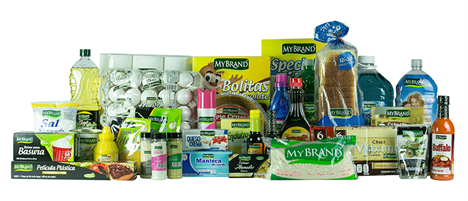Sixth installment of our new blog series that will bring front-row insights from our global network of IMRs focusing on COVID-19 recovery efforts in different markets. This installment is about Mexico.
As international export markets begin recovering from the COVID-19 pandemic, it is important to stay up to date on how your target markets are doing.
Food Export-Midwest and Food Export-Northeast have developed this blog series to bring you front-row insights from our network of In-Market Representatives (IMRs). Each blog will focus on one international market and give an overview of the recovery efforts in that market. This time we’ll examine Mexico.
This week’s spotlight is all about Mexico. Learn about the changes that took place in this market as a result of COVID-19 and practical tips that our In-Market Representative (IMR) for Mexico, Raul Caballero, has to offer to U.S. exporters looking to enter or re-establish themselves in the market.

1. What is the situation in your market regarding pandemic recovery at present?
Mexico has started to lift COVID-19 restrictions, especially those related to capacity of people allowed in businesses, at the end of 2021. The color-coded system established by the Mexican Department of Health at the start of the pandemic to identify the level of contagion risk per state, with red signifying higher risk and green, lower risk, show that most of the nation is now in a good place with all states in green zones. Mask use continues to be mandatory and Mexicans have largely been following recommended precautions, including vaccination. As of the second week of November 2021, 128 million people, close to 60% of Mexican adults, have been fully vaccinated. The risk of a fourth wave is latent, however, the prevention measures that will continue to be in-place are expected to help reduce the possible impact.
The Mexican economy is showing recovery signs in Q4 2021 after the deep deceleration experienced in 2020, due to COVID-19, and the setbacks caused by the second and third COVID-19 waves in the winter and summer earlier this year. The current global supply-chain disruption of manufacturing inputs such as electronic chips, has tempered economic recovery. Inflation in September was 6.24%, higher than the government’s expectation of 6.16%, and specialists consider that it will continue close the year at around 7% before starting to level down in Q1 2022. Nevertheless, increased mobility and jobs availability, have pushed the increase of private consumption.
2. How is that playing out in the food sector? What are you seeing in the retail sector? foodservice sector? Is there anything to note in specific industry sectors such as feed, pet food or seafood?
Supermarket retailers reported a large surge in the first half of 2020, at the beginning of the COVID-19 emergency, then a stabilization period in the third quarter of 2020, followed by continued growth throughout 2021. One of the biggest food trends during the pandemic has been healthy and natural foods, particularly plant-based or high-protein foods. Online sales and delivery apps played a huge role supporting sales in this segment during the pandemic.
The hotel and foodservice sectors in 2020, on the other hand, took a great hit due to the travel restrictions, lockdown period and capacity restrictions causing the permanent closure of many restaurants. In 2021, the foodservice sector is showing solid signs of recovery and the lifting of capacity restrictions in businesses and venues is aiding increased traffic in stores, restaurants, and movie theaters, though business still is far from the pre-pandemic situation
By the end of the third quarter of 2021, retail recovered 74% of traffic but sales are still 6.9% below the pre-pandemic levels. The tourism sector that lost 25% of its GDP in 2020 and 2021, is not expected to fully recover until 2023.
Trade shows in Mexico have started to take place in-person again starting in July 2021, though with lowered capacity. In October, the largest and most attended trade show in Mexico, the Mexican Retailers Association trade show, took place successfully, although not at full capacity and with no reports of COVID-19 spread. Music festivals have started too. This will definitely help to increase recovery in the foodservice sector.
Food ingredients is a very important segment as Mexico is the second largest food processing industry on the continent and the largest importer of intermediate food products from the U.S.
The increase of pet adoptions during the pandemic helped the growth of pet food in Mexico, putting the category among those with the highest growth with 8.1% increase in consumption and 8% in production by the end of 2020. Mexico hosts the regional headquarters of a number of international pet food producers and, in the last 20 years, the number of local manufacturers of dog and cat food increased significantly. The Mexican market is still more of an importer of pet food ingredients rather than finished products. Nevertheless, opportunities and demand for U.S. finished dry and wet pet food, as well as dog and cat treats, are present. An estimated 57 out of 100 Mexican households own a pet, with dogs making up 85% of all pets.
3. Have there been any structural changes in the market – ex. consolidations or ongoing issues related to imports (ex. testing) of which U.S. suppliers should be aware?
As of November 2021, the supply of imported processed foods has not had a visible impact from the current supply chain disruption and the retail trade has been able to keep up with the business. As mentioned before, the foodservice sector has yet to recover from the pandemic.
On the policy side, in 2020, Mexico updated already-strict labeling regulations for processed foods and non-alcoholic beverages intended to better inform the consumer about the content of these products. The updated regulations added visible front-of-package warning signs to advise consumers about products with high content of sugars, fat, calories, additives, or sugar substitutes. It was also aimed at preventing children from consuming such products.
4. What trends or developments have you seen in your market during the pandemic that you think are most likely to continue into the recovery and post-recovery period?
E-commerce was the winner during the pandemic, registering a growth of 81% over the segment’s value in 2019. Online sales saved the life of many small- and medium-size companies with digital channels becoming the source of 40% of their income according to the Mexican Association of Online Sales (AMVO).
As a result of the pandemic, the retail sector now has the task to increase the channels for consumers to access their products. Supermarket chains and the rest of the retail segment are now working on becoming omni-channel – with physical stores, e-commerce, and different digital payment options. During the pandemic, Mexican consumers became more confident in making online purchases and stores, in general, performed well in delivering customers’ orders safely and on-time. Mexican e-commerce will continue to develop and it is expected to grow by 225% in the next five years.
5. Could you share some practical marketing tips for U.S. suppliers to best position themselves to take advantage of the trends/developments you identified above?

Check out our Mexico Country Profile for further details.
Do you have specific questions for our market expert?
Consider a 30-minute video Virtual Consultation.
Your Connection To Growth®
©2024 Food Export Association of the Midwest USA and Food Export USA–Northeast. All Rights Reserved.
Food Export–Midwest and Food Export–Northeast prohibits discrimination in all its programs and activities on the basis of race, color, national origin, religion, sex, gender identity (including gender expression), sexual orientation, disability, age, marital status, familial/parental status, income derived from a public assistance program, political beliefs, reprisal or retaliation for prior civil rights activity. (Not all bases apply to all programs.) Persons with disabilities who require reasonable accommodations or alternative means of communication for program information (e.g., Braille, large print, audiotape, American Sign Language, etc.) should contact us. Additionally, program information may be made available in languages other than English.
To file a program discrimination complaint, complete the USDA Program Discrimination Complaint Form, AD-3027, found online https://www.ascr.usda.gov/filing-program-discrimination-complaint-usda-customer.
Food Export–Midwest and Food Export–Northeast reserve the right to deny services to any firm or individual which, in the sole opinion of Food Export–Midwest and Food Export–Northeast, does not comply with FAS, MAP or Food Export–Midwest and Food Export–Northeast regulations or policies, or otherwise offer the best opportunity to achieve its mission of increasing food and agricultural exports. Submission of any false or misleading information may be grounds for rejection or subsequent revocation of any application or participation. Food Export–Midwest and Food Export–Northeast are equal opportunity employers and providers.
